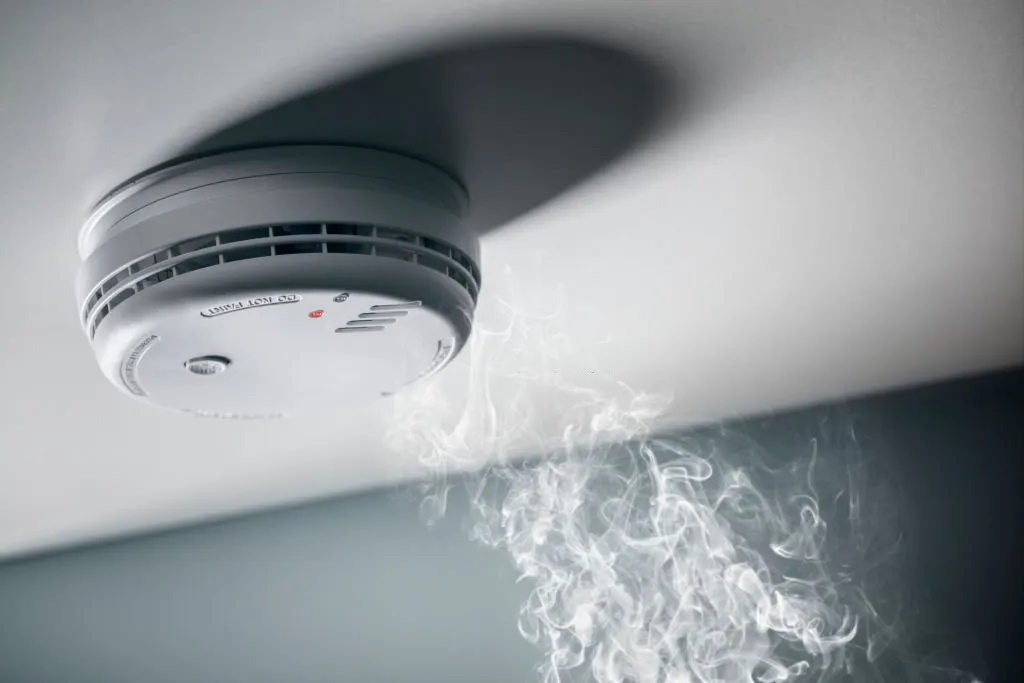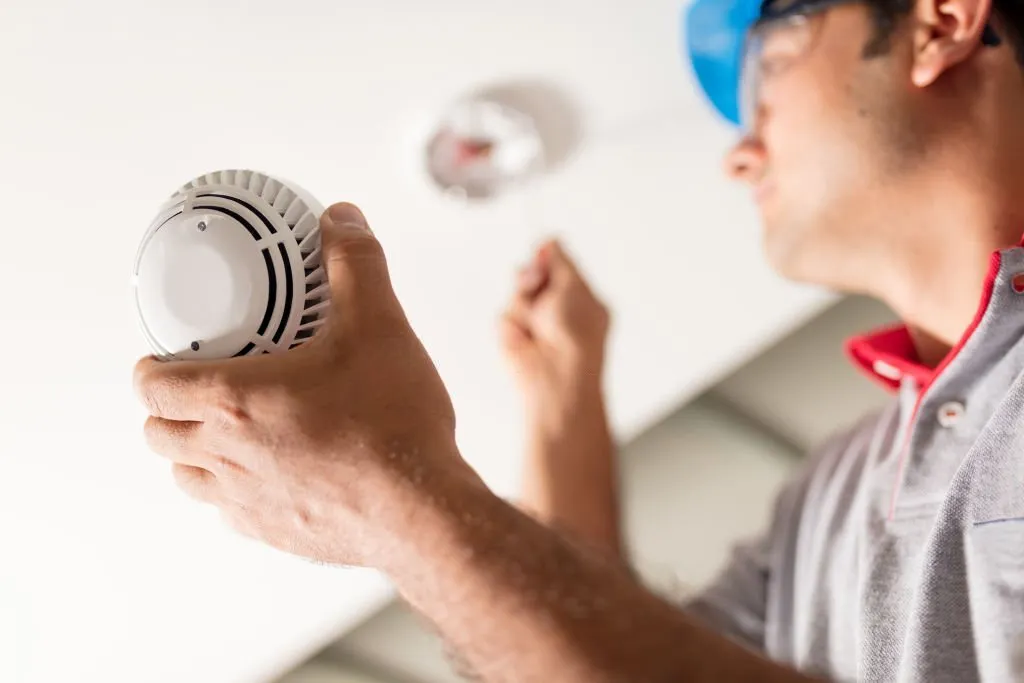Table of Contents
Learn how to inspect, test, and perform basic smoke detector repair. Discover when to call a professional and tips to keep your home’s smoke detectors in working order.
Smoke detectors are one of the most crucial safety devices in your home. When working properly, they can alert you to a fire in the early stages, giving you precious time to evacuate. However, over time, smoke detectors can malfunction or become less sensitive. Knowing when to repair or replace them is key to your family’s safety. This guide will cover everything you need to know about smoke detector repair, from troubleshooting common issues to general maintenance. With some simple DIY steps, you can keep your home’s smoke detectors in top working order.
What is a Smoke Detector and Why is it Important?
A smoke detector, also known as a smoke alarm, is a device that senses smoke and sounds an audible alarm to alert residents of a potential fire. Having working smoke detectors in your home drastically improves your chances of surviving a house fire. According to the National Fire Protection Association (NFPA), homes with smoke alarms experience a lower risk of fire-related injury or death. Properly functioning smoke detectors will quickly alert sleeping residents, providing precious seconds to evacuate safely. All homes should have smoke detectors installed on every floor, in every bedroom, and in central living areas.
Common Reasons for Smoke Detector Failure
Smoke detectors are extremely helpful safety devices when operating properly. However, they can sometimes malfunction and fail to detect smoke or set off false alarms. Here are some of the most common reasons smoke detectors fail:
| Reason for Smoke Detector Failure | Solution |
|---|---|
| Dead or missing batteries | Replace the battery with a fresh one. |
| The buildup of dust and dirt | Clean the sensor with a vacuum cleaner with a crevice attachment. |
| Insects or rodents | Call a qualified professional to remove the insects or rodents and repair the smoke detector if necessary. |
| Age/wear | Replace the smoke detector every 8-10 years. |
| Improper placement | Move the smoke detector to a more effective location. |
| Nuisance alarms | Move the smoke detector away from cooking fumes, dust, and insects. Make sure the smoke detector is installed correctly. Replace the smoke detector if it is frequently giving false alarms. |
Regularly testing and inspecting your smoke detectors will help identify issues to address through maintenance or smoke detector repair.
Testing and Inspecting Your Smoke Detectors
The NFPA recommends testing your smoke detectors at least once per month to ensure they are working properly. Here are some tips for monthly inspections:
| Smoke Detector Testing and Maintenance Task | Instructions |
|---|---|
| Test the alarm | Press the “Test” button and listen for a loud, piercing alarm sound. |
| Check the LED light | Check that the green or red LED light flashes when the test button is pushed. |
| Replace batteries | Replace batteries if needed. Smoke detectors should have fresh alkaline batteries at all times. |
| Vacuum the exterior | Vacuum the exterior of the smoke detector to remove dust, dirt, and cobwebs. |
| Check for obstructions | Verify that there are no obstructions blocking the vents where smoke enters. |
| Check placement | Make sure smoke detectors are on the ceiling or high on walls. |
| Test interconnected devices | If you have a system of interconnected smoke detectors, test them to make sure they all sound when one sounds. |
Following the manufacturer’s guidelines for testing and maintenance will help ensure your smoke detectors work when needed most.
DIY Smoke Detector Repair
Many basic smoke detector malfunctions can be fixed quickly through simple DIY troubleshooting and smoke detector repair:
| DIY Smoke Detector Repair | Solution |
|---|---|
| Replace batteries | If the detector is beeping, frequently false alarming, or fails to test properly, try replacing batteries first. Use name-brand alkaline batteries. |
| Clean the detector | Use compressed air or a vacuum with a soft brush to remove dust and debris inside and around the smoke detector’s vents. |
| Clear obstructions | Carefully remove any bugs or cobwebs that may be blocking smoke and airflow to the sensor. |
| Eliminate nuisance alarms | For frequent false alarms, relocate the device away from kitchens, bathrooms, or areas with humidity and steam. |
| Replace unit | If a smoke detector fails consistently or is over 10 years old, replacement is likely needed for optimal protection. |
Taking the time to regularly test, clean, and maintain smoke detectors often resolves issues and extends their lifespan. However, some malfunctions require expertise to properly address.
When to Call a Professional
While DIY battery changes and cleaning can fix many basic smoke detector issues, more complex repairs are best left to qualified electricians or alarm system technicians. Contact a professional for:
- Hardwired smoke detectors that are malfunctioning
- Smoke detectors that fail to test after troubleshooting
- Smoke detectors older than 10 years old that may need replacement
- Interconnected smoke detector systems with one or more faulty detectors
- Smoke detectors that continue to have false alarms frequently despite maintenance
- Smoke/fire alarm systems that are no longer code-compliant
The cost of professional smoke detector installation or repair is well worth it for the peace of mind and safety of your family. Never ignore consistent smoke detector issues.

Maintaining Your Smoke Detectors
Regular maintenance helps keep smoke detectors in good working order. Follow these guidelines:
- Test monthly and replace batteries yearly or whenever they are low.
- Clean detectors by vacuuming or blowing air into vents to remove dust, dirt, and debris.
- Replace smoke detectors every 8-10 years or per manufacturer guidelines. Mark replacement dates on the back.
- Interconnect hardwired detectors so that when one alarm, they all sound in unison. This provides more time to react.
- Eliminate cooking fumes and steam from kitchens and bathrooms that can cause false alarms.
- Install smoke detectors on every level of the home, inside each bedroom, and outside sleeping areas. Read also self serve car wash near me.
By inspecting, testing, troubleshooting, cleaning, and replacing smoke detectors as needed, you can keep these important safety devices ready to properly alert your household in the event of an emergency.
Smoke Detector Lifespans and Replacement
Smoke detectors eventually wear out and lose sensitivity. Manufacturer guidelines recommend replacing detectors every 8-10 years or per your specific model’s lifespan. Here are signs your smoke detectors need replacement:
- The units are over 10 years old or exceed the expiry date
- Detectors frequently false alarms indicating a faulty sensor
- You have to test units repeatedly before the alarm
- Detectors take a long time to sound when smoke is detected
- Batteries drain quickly indicating electronic issues
- Units do not sound loud alarms during testing
Always replace smoke detectors according to manufacturer specifications, even if they still appear to be working. Old ineffective detectors give a false sense of security. New Ul-listed units provide the highest level of fire protection.

Types of Smoke Detectors
There are two main types of smoke detectors – ionization and photoelectric. Both sense smoke but use different detection methods:
- Ionization – Best for detecting fast flaming fires; uses radioactive material; prone to nuisance alarms
- Photoelectric – Superior at sensing slow smoldering fires; uses light sensors; fewer false alarms
Dual sensor detectors combine both technologies for the widest fire detection coverage. Newer smart smoke detectors can send mobile alerts and integrate with smart home systems. Ensure all smoke detectors are UL-listed and approved.
Smoke Detector Placement Tips
Smoke detector placement is crucial for giving early fire warnings. Use these tips:
- Install on every level of the home including finished attics and basements.
- Place inside every bedroom and outside each sleeping area – like hallways.
- Mount either on the ceiling in the center of a room or high up on walls 6-12 inches from the ceiling.
- Avoid installation within 5 feet of vents, fans, windows, or anything that disrupts airflow.
- Do not put near kitchens or bathrooms where steam can trigger false alarms.
- Interconnect detectors for the quickest whole home alert. When one sounds, all detectors will activate.
Properly locating smoke detectors improves fire detection and safety. Follow manufacturer guidelines for exact placement.
Smoke Detector Regulations and Laws
Most areas have laws regarding smoke detector installation and maintenance. Common requirements include:
- Detectors on every level, in each bedroom, and in central halls.
- Powered by battery or hardwired to the home’s electrical system.
- Interconnection so if one detector alarms, all detectors alarm.
- Working smoke detectors at the sale or transfer of a property.
- Operable smoke detectors in rental units – responsibility varies by state laws.
- Smoke detector replacement every 8-10 years or per manufacturer.
Contact your local building department to understand smoke detector codes for homes in your jurisdiction. Staying code-compliant improves safety.
Smoke Detector Safety Tips
- Test detectors monthly and after returning from vacation.
- Replace batteries twice per year or whenever low. Use only name-brand alkaline batteries.
- Clean dust and dirt from detectors regularly to keep vents fully open.
- Never disable detectors or remove batteries because of nuisance alarms. Relocate instead.
- Develop and practice a home escape plan with two ways out of every room.
- When the alarm sounds, get out of the home immediately and call 911 once safely outside.
- Have an evacuation meeting spot. Never go back inside a burning building for any reason.
Properly installed and maintained smoke detectors save lives when a fire strikes. Following fire safety tips further protects your loved ones.
Summary of Smoke Detector Repair
Regular inspection, testing, maintenance, and timely smoke detector repair keep home safety devices working their best. Don’t ignore chirping, beeping, or faulty detectors. Address issues immediately through new batteries, cleaning, or professional replacement to provide optimum fire protection. Properly functioning smoke detectors provide an indispensable service – alerting your household at the first sign of smoke so everyone can safely evacuate. By understanding how smoke detectors work and what steps to take when they malfunction, you can ensure your family’s safety.





